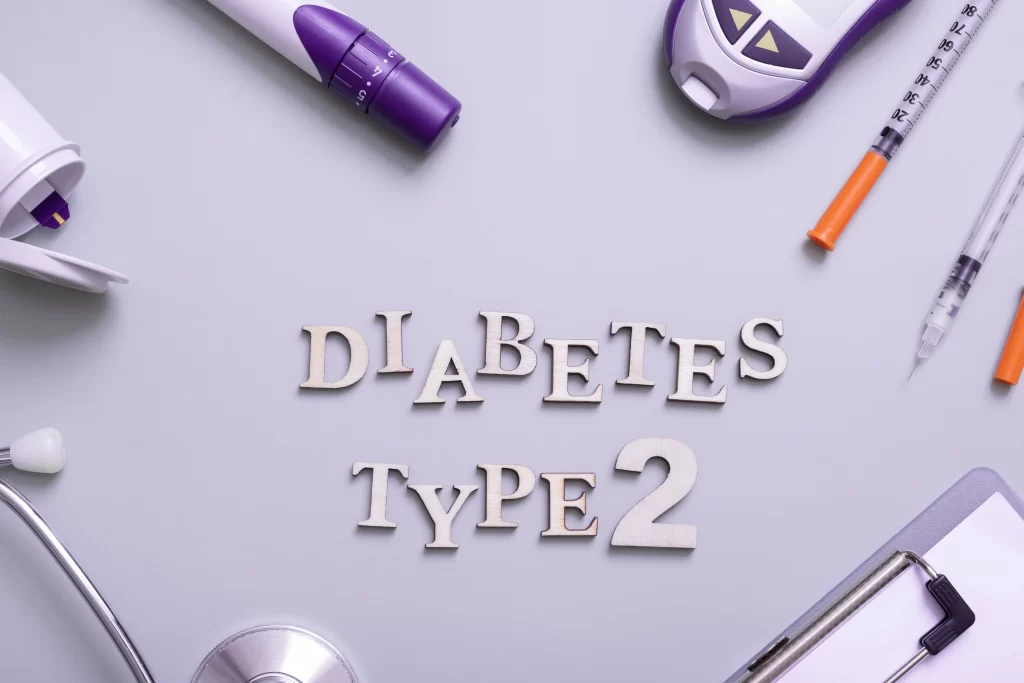
Type 2 Diabetes:
Type 2 diabetes is the most common form of diabetes among all types.
Overview
Type 2 diabetes is a chronic disease in which sugar or glucose levels build up in the blood.
Normally, the hormone insulin helps move glucose from the blood into the cells to be used as energy. However, in type 2 diabetes, the body’s cells cannot respond well to insulin. In the later stages of the disease, the body also fails to produce enough insulin.
Uncontrolled type 2 diabetes can lead to chronic hyperglycemia, causing multiple symptoms and potentially serious complications.
What are the complications that Type 2 Diabetes will lead to?
Potential complications of high blood sugar levels from Type 2 diabetes can include:
-
Digestive problems, including gastroparesis.
-
Eye problems, including diabetes-related retinopathy.
-
Foot problems, including leg and foot ulcers.
-
Gum disease and other mouth problems.
-
Hearing loss.
-
Heart disease.
-
Kidney disease.
-
Liver problems, including non-alcoholic fatty liver disease.
-
Peripheral neuropathy (nerve damage).
-
Sexual dysfunction.
-
Skin conditions
-
Stroke
-
Urinary tract infections and bladder infections.
Signs & Symptoms
Onset of diabetes could show following symptoms:
Persistent hunger
Lack of energy
Exhaustion
Excessive thirst
Frequent urination
Hazy vision & discomfort
Causes
Insulin is a naturally occurring hormone. When you eat, your pancreas produces and releases it. When you have type 2 diabetes, your body becomes insulin resistant. Your body no longer utilizes hormones as effectively. This forces the pancreas to work harder to produce more insulin.
Over time, this can damage the cells of the pancreas. Eventually, the pancreas may no longer be able to produce insulin. When enough insulin isn’t produced or the body doesn’t use it efficiently, glucose builds up in the bloodstream. As a result, your body’s cells are starving for energy. Doctors don’t know exactly what triggers this chain of events. It may be related to pancreatic cell dysfunction or cell signalling and regulation.
While lifestyle choices are typically what trigger type 2 diabetes, you may be more likely to be diagnosed with following conditions:
- A genetic predisposition to developing type 2 diabetes in your family
- A genetic predisposition to developing obesity in your family, which can increase the risk of insulin resistance and diabetes
- At least 45 years old
How to prevent Type 2 Diabetes?
You can prevent or delay Type 2 diabetes by:
- Eating a healthy diet
- Exercising
- Losing weight
Diagnosis of Type 2 Diabetes
Whether or not you have prediabetes, you should see your doctor right away if you think you may be experiencing symptoms of diabetes. Blood tests can reveal a lot of information to your doctor. The following diagnostic tests may be performed:
Measure average blood glucose levels over the two or three months’ period during this test. For this test, you don’t have to fast, and the results will help your doctor make a diagnosis. A test for glycosylated haemoglobin is another name for it.
The amount of glucose in your plasma is determined by this test. Before taking medication, you might need to fast for eight hours.
In this test, blood is taken three times: just before the test, an hour after the test, and two hours after the test. The test outcomes demonstrate how well your body handles glucose both before and after.
Type 1 V/S Type 2 diabetes:
Type 2 diabetes is not the same as type 1 diabetes. In Type 1 diabetes, the pancreas does not produce insulin. In type 2, the pancreas does not produce enough insulin and the insulin it does not always work properly. Both types are forms of diabetes mellitus, meaning they lead to high blood sugar (hyperglycaemia).
Type 2 diabetes usually affects older people, but is more common in children. Type 1 diabetes usually develops in children or young adults, but it can develop in people of any age.
Risk Factors
There are some risk factors for type 2 diabetes that are out of your control (such as age and race as mentioned above), but certain lifestyle choices can put you at an increased risk of developing type 2 diabetes and becoming ill. There is a nature.
Living with Obesity
If you are overweight, you may have more adipose tissue and your cells may be more resistant to insulin.
Sedentary lifestyle
Regular physical activity helps cells respond better to insulin.
Eat lots of highly processed foods
Highly processed foods can be high in hidden sugars and refined carbohydrates. If your life calls for a more “grab and go” eating style, talk to your doctor or nutritionist about nutritious replacements. two conditions that cause it, you may also be at increased risk.

